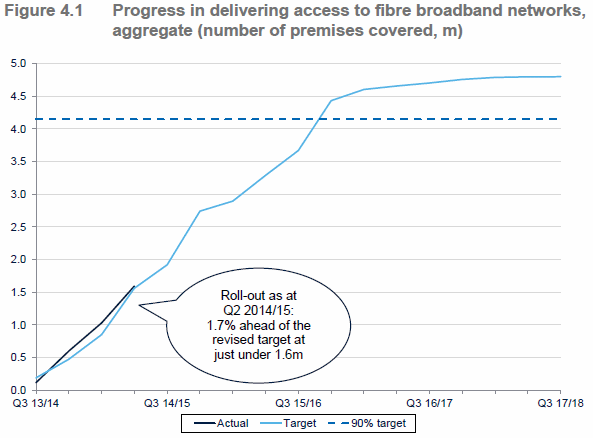Independent Test of UK Fibre Broadband Rollout Rules BDUK is “Effective”
The Government’s £1.7bn state aid supported Broadband Delivery UK project, which aims to make superfast broadband (24Mbps+) speeds available to 95% of the country by 2017/18 and is largely dominated by BT, has been deemed “effective” by a new independent evaluation. But the report also raises a few concerns.
The European Commission (EC) requires, as part of its decision to grant State Aid clearance to BDUK, that the national broadband programme be evaluated to ensure that it complies with the relevant terms for using public funds. It must also be effective in achieving the stated objectives and not create undue distortions of competition or EU trade.
Advertisement
As such BDUK commissioned Oxera to undertake an “independent evaluation” of the United Kingdom’s National Broadband Scheme, although perhaps this would have had more weight if BDUK wasn’t also the commissioning authority. Never the less Oxera’s evaluation has now concluded that the scheme was “designed in an appropriate manner” and “has been effective in its role“.
The report also praised the rapid pace of BDUK’s progress, not least in regards to service take-up. Oxera states that take-up has been “considerably higher than BT modelled in its bids“, which were based on 20% take-up across all intervention areas (most were predicted to reach this by 2018/19).
But, as of Q2 2014/15, overall take-up by premises passed as a result of the Scheme was 8.2% compared with expected take-up of 1.8% and general roll-out progress has kept to target. This is all good news for Claw-back, which allows some of the funding to be reinvested into further improvements after the 20% target is reached.
Indeed the scheme most recently confirmed that over 2.5 million additional homes and businesses have now been put within reach of a “fibre broadband” network thanks to BDUK and BT’s efforts, although the related chart below is based on earlier data (note: this chart is also more reflective of the original 90% coverage target for early 2016).
Advertisement

But Oxera’s report isn’t entirely without criticism and indeed an ex post evaluation identified a “small number of potential compliance issues“, for which the EC has indicated that it requires further information from BDUK (e.g. the definition of speed thresholds for mapping purposes, the decision not to publish a national infrastructure database, the re-mapping of some grey areas as white for Phase Two [95% coverage target] projects and some other project-specific compliance issues)
The report also makes a few general recommendations and we’ve summarised some of their most interesting comments below for your reading pleasured.
Top Highlights from Oxera’s Report (Opinions and Recommendations)
* The fact that BT has become the sole supplier on the framework contract may not, in itself, be an issue in the short term if BT is providing value for money and all other suppliers would offer a higher cost. To this extent, it is not apparent that greater coverage could have been achieved for the same amount of funding via another mechanism or supplier.
However, the lack of competition for local tenders raises the question as to whether BT has now locked in an incumbency advantage that is of future detriment to competition. This issue relates not only to BT’s actual costs, but also to rivals’ beliefs about whether it is worthwhile to bid against BT.
* Both the National Audit Office and Public Accounts Committee have argued for greater cost transparency in future.
* Oxera observes that there were limitations in the data that BDUK had available at the contracting phase in terms of being able to assess whether the build of BT’s bid prices was reasonable. While access to the bid model may have helped BDUK to understand the basis on which BT’s bids were created, it is not obvious that this would have provided a robust basis for estimating actual likely future costs of the Scheme and the value for money represented by bids. The value-for-money safeguards reduce the scope for limited transparency over the build-up of the bid price to result in higher outturn costs.
* There has been no formal request for BT’s new passive access product (PIA Plus). The immediate-term market structure appears to be based on (active inputs) service-based competition.
* Where an incumbent supplier is in a position to win the majority of funding, client bodies should either explicitly consider how to encourage entry by competitors or, where this is not feasible, look to ensure that there are contractual or regulatory safeguards in place, such as those used by BDUK, to prevent the incumbent from inflating its deployment costs.
* Member States should put in place robust processes to ensure that providers do not hold back on their commercial investments in order to receive state funding for more projects. There appears to be evidence of local bodies including white areas in Phase Two roll-out plans that BT had previously indicated were planned for its commercial investment and had been classified as grey. We note, however, that there is also evidence of areas initially classified as white subsequently being covered by BT Openreach’s commercial roll-out based on updated modelling.
* The current contract design provides the supplier with strong incentives not to overspend, but limited incentive to make further capital savings (as it is paid only for its actual level of expenditure, where this is below the forecast level). This approach reflected the information asymmetry at the time of the initial Scheme notification. However, BDUK has now developed its understanding of BT’s cost base.
Consequently, BDUK could consider whether it would be possible to design future contracts in a way that would provide the supplier with enhanced incentives to secure capital efficiencies (i.e. some form of efficiency-sharing). Any such efficiency-sharing mechanism would need to balance the benefits of stronger efficiency incentives with the risk for suppliers to inflate their bids in order to benefit from ‘false’ cost reductions relative to the bid.
We particularly note Oxera’s observation about BDUK’s impact on commercial investments, having ourselves also noted some locations that BT previously deemed commercially viable and only to later see some of those same areas finding their way into the BDUK project. But Oxera’s report also highlights a bit of quid pro quo with this aspect, thus it’s not a clear cut case.
In relation to that we’ve also seen other situations, such as where BT has used public funding from BDUK to help deploy fibre broadband into locations where rival commercial operators are already doing similar work. Several recent examples of this can be seen in Gigaclear’s past roll-out plan, as well as B4RN’s deployment of FTTH into Dolphinholme (here).
Advertisement
More often than not the local authority is most to blame for the above issues by being overly bureaucratic in its approach (e.g. perhaps consciously shunning rivals through the Open Market Review process) and failing to adopt a more dynamic common sense approach to the way public funding is distributed.
But overall it appears as if BDUK has passed the key tests and that means we can expect more of the same going forward. Broadly the core goal of improving national broadband connectivity is being achieved and keeping to target, although hopefully Oxera’s criticisms are also considered for future policy design.
Lest we not also forget that the project will face greater challenges as it slowly pushes out into increasingly remote areas, which could raise costs and slow progress.
Oxera’s Full Report
https://www.gov.uk/government/uploads..report.pdf
Mark is a professional technology writer, IT consultant and computer engineer from Dorset (England), he also founded ISPreview in 1999 and enjoys analysing the latest telecoms and broadband developments. Find me on X (Twitter), Mastodon, Facebook, BlueSky, Threads.net and Linkedin.
« BT Take Ofcom’s FTTC Margin Squeeze Test to Competition Authority

















































Comments are closed